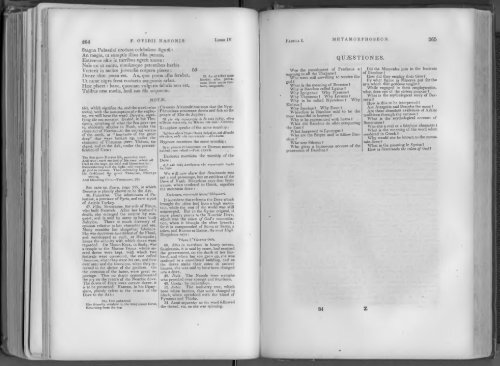THE METAMORPHOSES OF PUBLIUS OVIDIUS NASO
THE METAMORPHOSES OF PUBLIUS OVIDIUS NASO
THE METAMORPHOSES OF PUBLIUS OVIDIUS NASO
Create successful ePaper yourself
Turn your PDF publications into a flip-book with our unique Google optimized e-Paper software.
264 F. OVIDII N ASONIS LIBER IV<br />
Stagna Palaestini credunt celebrasse figura:<br />
An magis, ut sumptis ilJius filia pennis,<br />
Extremes altis in turribus egerit annos:<br />
Na'is an ut cantu, nimiumque potentibus herbis<br />
Verterit in tacitos juvenilia corpora pisces :<br />
Donee idem passa est. An, quse poma alba ferebat,<br />
Ut nunc nigra ferat contactu sanguinis arbor.<br />
Haec placet: hanc, quoniam vulgaris fabula non est,<br />
Talibus orsa modis, lana sua fila sequcnte.<br />
(de), which signifies the, and the word cetut<br />
(cetia), with the assumption of r for eupho<br />
ny, we will have the word Dercetis, signi<br />
fying the sea-monster. Hestod, in his 'I he-<br />
ogony, speaking of whnt the Sea gave rise<br />
to, evidently alludes to Noah, under the<br />
character oi NereuB to the central waters<br />
of the earth, or " fountains of the great<br />
deep" that were broken up, under ihe<br />
character of Thaumas (own, Thaum, the<br />
' abyss), and to ihe Ark, under the personi<br />
fication of Ceto:<br />
The Sea gave Nereus life, unerring seer.<br />
And true; most ancient of hie race, whom all<br />
Hail as ihe sage, lor mild and blameless he:<br />
Remembering Elill the riglu; still merciful<br />
As juf,t in fouiutds. Then embracing Earth,<br />
He fashioned the grent Tliaumas, Phorcys<br />
Btronq, *<br />
And blooming Ceto. <strong>THE</strong>OGONY, 233.<br />
NOT^E.<br />
See note on Sacra, page 255, in which<br />
Dercetis is plainly shown to be the Ark.<br />
46. Fulastini. The inhabitants of Pa<br />
lestine, a province of Syria, and now a part<br />
of Asiatic Turkey.<br />
47. Filia. Semiramis, the wife of Ninus,<br />
who built Nineveh. After her husband's<br />
death, she enlarged the empire by con<br />
quest, and is saia by some to have built<br />
Babylon. There is much diversity of<br />
opinion relative to her character and era.<br />
Many consider her altogether fabulous.<br />
She was doubtless an emblem of the Flood,<br />
and worshipped as such, at Hierapolis;<br />
hence the sanctity with which doves were<br />
regarded. On Mount Eryx, in Sicily, was<br />
a temple to the Marine Venus, where sa<br />
cred doves were kept, with which two<br />
festivals were connected, the one called<br />
'Avaydfyw, when they were let out, and flew<br />
over sea: and the Karay^ym, when they re<br />
turned to the shrine of the goddess. On<br />
the occasion of the latter, were great re<br />
joicings. This no doubt commemorated<br />
the joy on the return of the Noachic dove.<br />
The doves of Eryx were carrier doves, it<br />
is to be presumed Nonnus, in his Diony<br />
siacs, plainly refers to the return of the<br />
Dove to the Ark:<br />
She first unbarred<br />
Her friendly window to ihe auspicii :iouB Dove,<br />
Returning from ihe sen<br />
50<br />
SI. An nt arbor qnra<br />
fcrebat alba pome,<br />
nunc fcrnt nigra con-<br />
tuctu Banguima.<br />
Clemens Alexandrinus says that the Syro<br />
Phenicians reverence doves and fish as the<br />
people of Elis do J upiter :<br />
Of jur raj ireptOTepas bl 61 TOvg l\5vt, OVTU<br />
oiflovct srepirrws, ws HXciot rdv &ia. — COHORT.<br />
Xenophon speaks of the same worship :<br />
'IxSwwv ovS oi £ijpoi ,<br />
CIVK ciuv, oiieji rnf irefiicrcpaf. — ANABASIS.<br />
Hyginus mentions the same worship :<br />
Syri pisces et columhus ex Deorum numero<br />
habent; non edunt. FAB. cxcvii.<br />
Diodorus mentions the worship of the<br />
Dove:<br />
&ii













